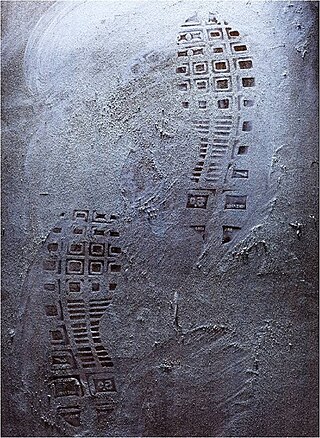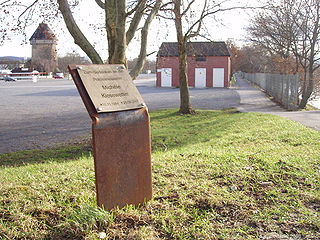
Forensic science, also known as criminalistics, is the application of science principles and methods to support legal decision-making in matters of criminal and civil law.

Forensic palynology is a subdiscipline of palynology, that aims to prove or disprove a relationship among objects, people, and places that may pertain to both criminal and civil cases. Pollen can reveal where a person or object has been, because regions of the world, countries, and even different parts of a single garden will have a distinctive pollen assemblage. Pollen evidence can also reveal the season in which a particular object picked up the pollen. Recent research into forensic palynology has seen advancements in DNA barcoding from pollen, to the level of singular pollen molecules, allowing DNA profiles to be created from singular palynomorphs, streamlining the efficiency and accuracy of taxonomic identification.

Forensic engineering has been defined as "the investigation of failures—ranging from serviceability to catastrophic—which may lead to legal activity, including both civil and criminal". The forensic engineering field is very broad in terms of the many disciplines that it covers, investigations that use forensic engineering are case of environmental damages to structures, system failures of machines, explosions, electrical, fire point of origin, vehicle failures and many more.
Chain of custody (CoC), in legal contexts, is the chronological documentation or paper trail that records the sequence of custody, control, transfer, analysis, and disposition of materials, including physical or electronic evidence. Of particular importance in criminal cases, the concept is also applied in civil litigation and more broadly in drug testing of athletes and in supply chain management, e.g. to improve the traceability of food products, or to provide assurances that wood products originate from sustainably managed forests. It is often a tedious process that has been required for evidence to be shown legally in court. Now, however, with new portable technology that allows accurate laboratory quality results from the scene of the crime, the chain of custody is often much shorter which means evidence can be processed for court much faster.

Trace evidence occurs when objects make contact, and material is transferred. This type of evidence is usually not visible to the naked eye and requires specific tools and techniques to be located and obtained. Due to this, trace evidence is often overlooked, and investigators must be trained to detect it. When it comes to an investigation trace evidence can come in many different forms and is found in a wide variety of cases. This evidence can link a victim to suspects and a victim or suspect to the crime scene.

Digital forensics is a branch of forensic science encompassing the recovery, investigation, examination, and analysis of material found in digital devices, often in relation to mobile devices and computer crime. The term "digital forensics" was originally used as a synonym for computer forensics but has expanded to cover investigation of all devices capable of storing digital data. With roots in the personal computing revolution of the late 1970s and early 1980s, the discipline evolved in a haphazard manner during the 1990s, and it was not until the early 21st century that national policies emerged.
False evidence, fabricated evidence, forged evidence, fake evidence or tainted evidence is information created or obtained illegally in order to sway the verdict in a court case. Falsified evidence could be created by either side in a case, or by someone sympathetic to either side. Misleading by suppressing evidence can also be considered a form of false evidence ; however, in some cases, suppressed evidence is excluded because it cannot be proved the accused was aware of the items found or of their location. The analysis of evidence may also be forged if the person doing the forensic work finds it easier to fabricate evidence and test results than to perform the actual work involved. Parallel construction is a form of false evidence in which the evidence is truthful but its origins are untruthfully described, at times in order to avoid evidence being excluded as inadmissible due to unlawful means of procurement such as an unlawful search.

Fire investigation, sometimes referred to as origin and cause investigation, is the analysis of fire-related incidents. After firefighters extinguish a fire, an investigation is launched to determine the origin and cause of the fire or explosion. These investigations can occur in two stages. The first stage is an investigation of the scene of the fire to establish its origin and cause. The second step is to conduct laboratory examination on the retrieved samples.Investigations of such incidents require a systematic approach and knowledge of fire science.
A crime laboratory, often shortened to crime lab, is a scientific laboratory, using primarily forensic science for the purpose of examining evidence from criminal cases.

Forensic photography may refer to the visual documentation of different aspects that can be found at a crime scene. It may include the documentation of the crime scene, or physical evidence that is either found at a crime scene or already processed in a laboratory. Forensic photography differs from other variations of photography because crime scene photographers usually have a very specific purpose for capturing each image. As a result, the quality of forensic documentation may determine the result of an investigation; in the absence of good documentation, investigators may find it impossible to conclude what did or did not happen.
The following outline is provided as an overview of and topical guide to forensic science:
Forensic science holds the branch of forensic photography which encompasses documenting both suspected and convicted criminals, and also the crime scenes, victims, and other evidence needed to make a conviction. Although photography was widely acknowledged as the most accurate way to depict and document people and objects, it was not until key developments in the late 19th century that it came to be widely accepted as a forensic means of identification.
Evidence management is the administration and control of evidence related to an event so that it can be used to prove the circumstances of the event, and so that this proof can be tested by independent parties with confidence that the evidence provided is the evidence collected related to the event.
Forensic entomology deals with the collection of arthropodic evidence and its application, and through a series of tests and previously set rules, the general admissibility of said evidence is determined. Forensic entomology may come into play in a variety of legal cases, including crime scene investigation, abuse and neglect cases, accidents, insect infestation, and food contamination.
Entomological evidence collection is the process of collecting evidence based on insect clues used in criminal investigations. If evidence is not carefully preserved at a crime scene after a death, it may be difficult or impossible for an entomologist to make an accurate identification of specimens, if for example, all morphological characteristics are not preserved.

The Phantom of Heilbronn, often alternatively referred to as the "Woman Without a Face", was a hypothesized unknown female serial killer whose existence was inferred from DNA evidence found at numerous crime scenes in Austria, France and Germany from 1993 to 2009. The six murders among these included that of police officer Michèle Kiesewetter, in Heilbronn, Germany on 25 April 2007.

Glove prints, also sometimes described as gloveprints or glove marks, are latent, fingerprint-like impressions that are transferred to a surface or object by an individual who is wearing gloves.
Contaminated evidence is any foreign material that is introduced to a crime scene after the crime is committed. Contaminated evidence can be brought in by witnesses, suspects, victims, emergency responders, fire fighters, police officers and investigators.

Forensic firearm examination is the forensic process of examining the characteristics of firearms or bullets left behind at a crime scene. Specialists in this field try to link bullets to weapons and weapons to individuals. They can raise and record obliterated serial numbers in an attempt to find the registered owner of a weapon and look for fingerprints on a weapon and cartridges.

Evidence packaging involves the specialized packaging methods and materials used for physical evidence. Items need to be collected at a crime scene or a fire scene, forwarded to a laboratory for forensic analysis, put in secure storage, and used in a courtroom, all while maintaining the chain of custody. Items might include DNA, drugs, hair samples, body parts, blood samples, sperm, knives, vomit, firearms, bullets, fire accelerants, computers, checkbooks, etc.













